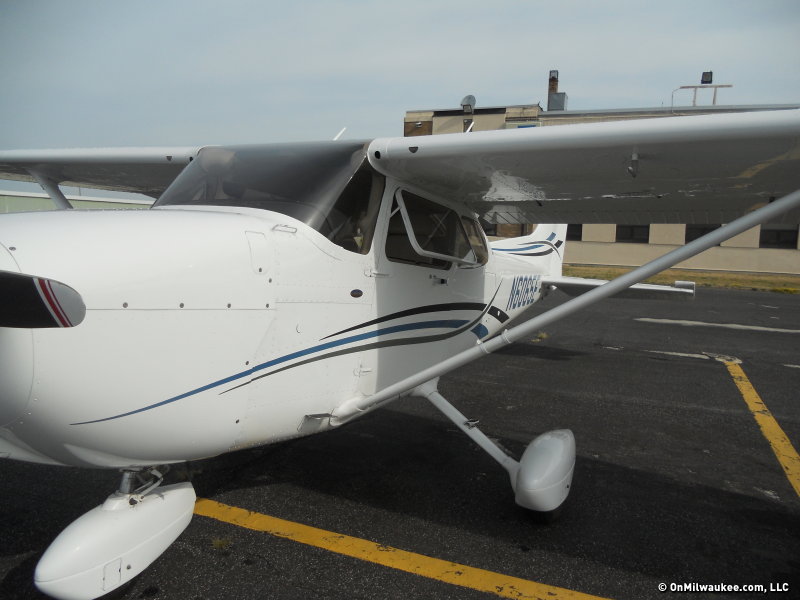 Interstate 94, linking Milwaukee and Chicago, is one of the nation's busiest freeways, and a trip along this corridor reveals some interesting sights along the way. Fireworks stores, adult bookstores, the famous Mars Cheese Castle, the University of Lawsonomy and mammoth truck stops are the landmarks everyone knows.
Interstate 94, linking Milwaukee and Chicago, is one of the nation's busiest freeways, and a trip along this corridor reveals some interesting sights along the way. Fireworks stores, adult bookstores, the famous Mars Cheese Castle, the University of Lawsonomy and mammoth truck stops are the landmarks everyone knows.
But around the Hwy. 20 exit for Racine you may spy, in the sky above, a small glider gracefully and gently soaring over the rush of traffic and dipping down onto the narrow landing strip to the east of the freeway.
If you double back and get off the next exit you'll eventually land at the Sylvania Airport in Sturtevant. The inconspicuous airfield is home to glider rides and the sport of soaring.
What's soaring? The sport takes the science of physics and flying, and combines them into a sleek aircraft that doesn't contain a propeller or engine.
What seems impossible to most is, in fact, one of the safest forms of flight. It's known in the soaring community as powerless flight.
The man responsible for bringing the sport to the area is Steve Stauber, who bought the airport four years ago from a man who decided to move on to the more lucrative job of a commercial pilot. At that time, almost nobody around Milwaukee had an outlet to participate.
Fortunately for gliding enthusiasts, Stauber stepped in and decided to keep the business running. The three sailplanes were relatively inexpensive. "Gliders cost less than a car," says Stauber. "The high-performance gliders cost around $15,000."
The sport of gliding with a sailplane is quite an experience, says Stauber. In order to get the planes off the ground, which come in a variety of single or double-seat crafts, a tow hook must be attached to the glider. A tow plane then pulls the glider off the runway and carries the craft to a variety of altitudes where it is released into the sky.
The most interesting sight in the ritual of lifting the sailplane is watching it get pulled into the sky long before the tow plane takes off from the runway. A powerless plane being dragged behind a former crop duster tow plane is quite a sight.
The pilot of either airplane has the opportunity to release the tow cable, however it is usually the sailplane pilot who releases it first. Before release, the sailplane pilot employs a variety of interesting signals. These include fluttering the wings, or wagging the rudder to point the pilot of the tow plane towards good soaring conditions, which may include newly forming cumulus clouds that provide excellent sources of lift for the sailplane.
Physics takes over as the pilot looks for cloud formations and weather patterns to keep the plane flying. Unlike power planes, a sailplane needs to find "thermals" to stay in the air.
Thermals are columns and channels of warm air that rise from the ground, especially from dark plowed fields or blacktop parking lots. The source of lift found in the thermals can carry the sailplane upward to higher elevations. If there are no thermals, the sailplane would eventually be pulled toward to the Earth where it would make a normal landing like any other plane.
In some cases, thermal lifts -- especially in desert regions -- have carried sailplanes to altitudes of 25,000 feet. Some pilots have pulled their crafts as high as the altitudes that commercial jets occupy.
 In addition to the thrill of soaring, Stauber stresses that perhaps the most enjoyable part of gliding is that it's a social organization.
In addition to the thrill of soaring, Stauber stresses that perhaps the most enjoyable part of gliding is that it's a social organization.
"When we fly gliders, it is a social event. You sit around and talk about flying. People come here at 10 a.m. who are set to fly at 4 p.m. to talk and socialize. It's very relaxing, and we never rush anybody."
The whole sport of flying, in general, whether it's power or glider, is a social event. "If you own your own plane, your family takes off, and you fly to airport 'XYZ,' land, you have lunch and then you come back," says Stauber.
And while weather conditions can change at a moment's notice, it is always known that if a plane cannot get in the air, then plenty of conversations about flight will be featured in the hangar.
People often wonder about the safety of the sport. Even children as young as 14 can learn to fly a glider solo and eventually secure their FAA certified license.
Stauber says he took up an interest in gliding and flight when he was in high school. He took 30 years off after college, but had nine years of paraglider experience, and the idea of soaring always interested him. "The idea was fascinating -- no engine, no noise. But in the Midwest there was no place to do it, until I found Sylvania. I took up flying and started taking lessons."
{INSERT_RELATED}When you first pull into the airport parking lot, you'll likely see a crowd of people hiding from the bright summer sun seated in a circle of lawn chairs. When they are not flying, or learning to fly with certified FAA instructors, they are discussing a variety of issues; who just flew, who is flying now, who is set to fly, and how they flew.
In fact, a person striving to get his pilot's license would almost be smart to sit in on these tiny circles of flight knowledge, where so much about sailplanes and gliding becomes apparent.
Sylvania has already had its share of interesting pilots; one young man who entered the Air Force Academy started up lessons. "He came here to learn, which was good for his career. He wants to be the space shuttle pilot, and came here to learn the principles of gliding. He soloed in 16 flights," says Stauber proudly. Stauber notes that the space shuttle would be an interesting avenue for a pilot licensed in gliders. Upon reaching the Earth's orbit, the shuttle uses basic principles of gliding to land.
The other mix of pilots range from those licensed just in gliding to those who have commercial experience. "A United pilot flies here with his family, and he takes his son up with him. We are very diverse; this is a guy who is trained in the most state-of-the-art equipment, and he comes here to relax," says Stauber.
Unique and diverse don't even begin to describe those who desire to take up sailplanes. Teachers, kids, other pilots, anyone can learn to fly.
Sylvania Airport soars weekends from May until November. Spectators and visitors are always welcome to watch and even bring their picnic lunch. Introductory flights ($95) are available that release from 3,000 feet with excellent views of downtown Milwaukee and Chicago skylines. A flight releasing at 5,000 feet for nearly 40 minutes is also offered ($149). Or you can visit the airport to learn more about becoming a pilot yourself. They offer lessons to new pilots, and even to those looking to make the transition from power aircraft to sailplanes.
Sylvania Airport is located at 2624 S. Sylvania Ave. in Sturtevant. Call (262) 886-4975 for more information, or to book a flight.




